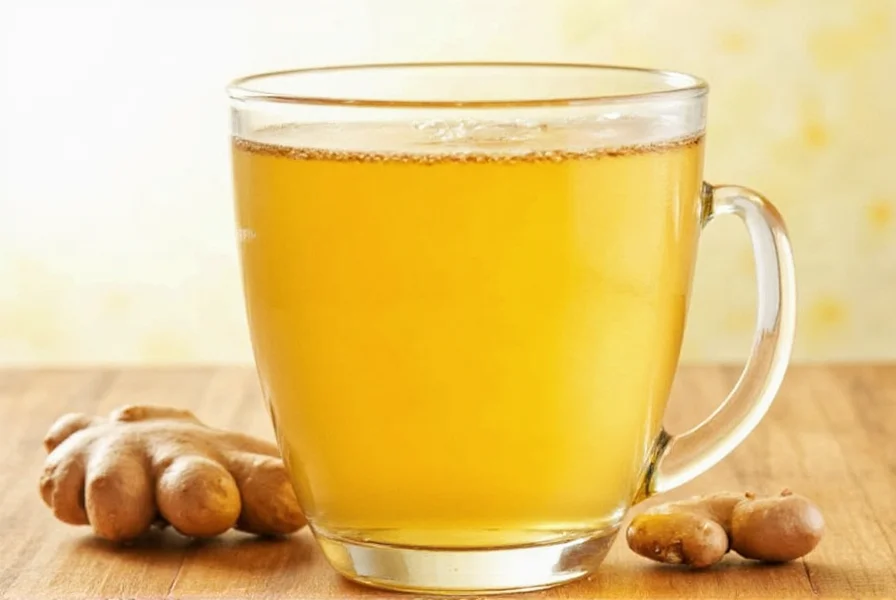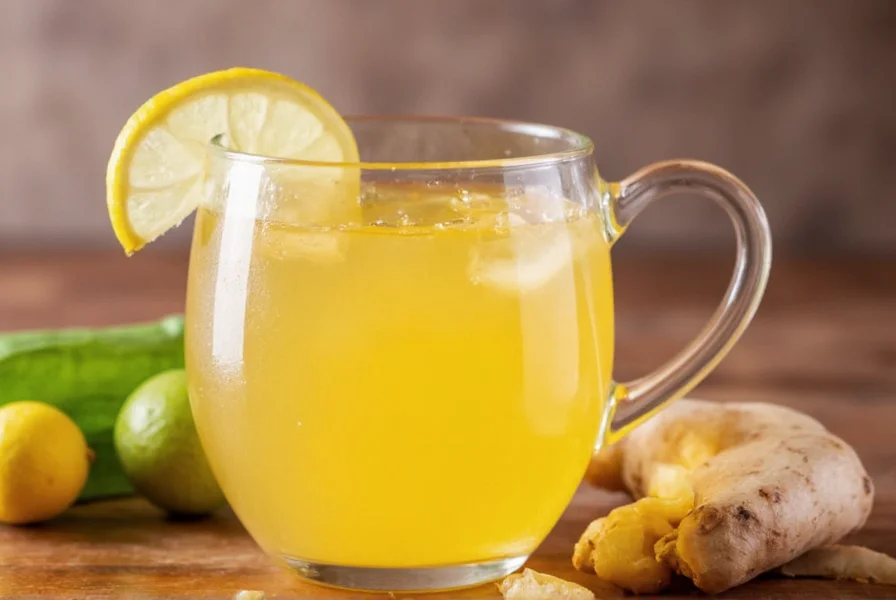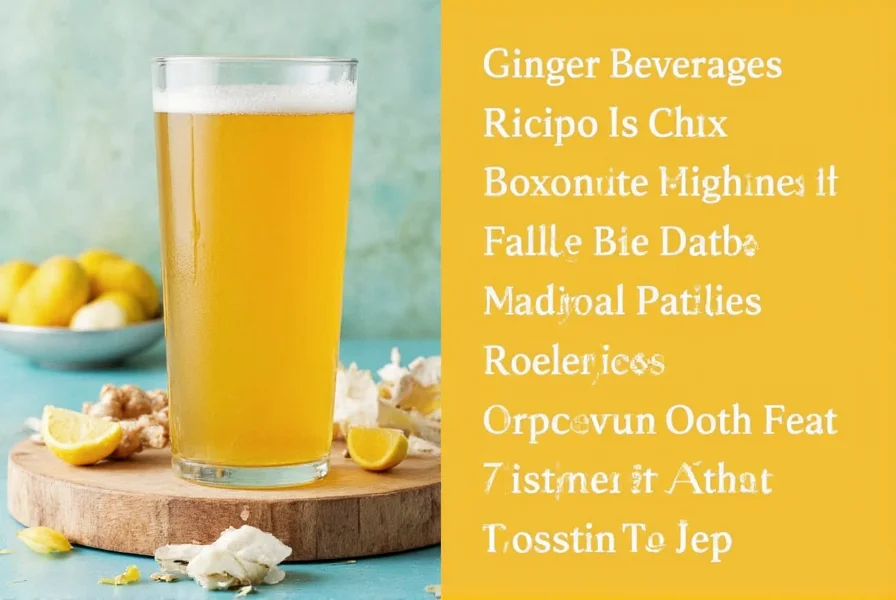Ginger beverages have been enjoyed across cultures for centuries, valued for both their distinctive taste and potential wellness properties. From simple homemade ginger teas to commercially produced ginger ales, these drinks offer a refreshing alternative to sugary sodas and artificial beverages. The active compounds in ginger, particularly gingerols, contribute to the characteristic pungent flavor and are the subject of ongoing scientific research regarding their effects on the human body.
Types of Ginger Beverages
Ginger appears in numerous beverage forms, each with unique preparation methods and flavor profiles:
| Type | Preparation Method | Alcohol Content | Key Characteristics |
|---|---|---|---|
| Ginger Tea | Steeping fresh or dried ginger in hot water | Non-alcoholic | Mild, warming, often combined with lemon or honey |
| Ginger Ale | Carbonated drink with ginger flavoring | Non-alcoholic | Sweeter commercial version, lighter ginger flavor |
| Ginger Beer | Fermented ginger, sugar, and water | Traditionally non-alcoholic (modern craft versions may contain alcohol) | Stronger ginger flavor, more complex than ginger ale |
| Ginger Lemonade | Fresh ginger juice mixed with lemon juice and sweetener | Non-alcoholic | Citrus-forward with spicy ginger notes |
Historical and Cultural Significance
Ginger's journey as a beverage ingredient spans continents and centuries. Originating in Southeast Asia, ginger spread through ancient trade routes to become a staple in traditional medicine systems worldwide. In Ayurvedic practice, ginger drinks have been used for digestive support for over 2,000 years. Traditional Jamaican ginger beer, made through natural fermentation, represents one of the earliest forms of what we now recognize as craft sodas. Asian cultures have long prepared simple ginger teas for both medicinal and culinary purposes, while European apothecaries incorporated ginger into various tonics during the Middle Ages.
Nutritional Profile of Ginger Beverages
The nutritional value of ginger beverages varies significantly based on preparation method. Homemade versions using fresh ginger root contain gingerols, the bioactive compounds responsible for ginger's characteristic flavor and potential health properties. Commercial ginger ales often contain minimal actual ginger, relying instead on artificial flavors and high amounts of added sugar. A typical 8-ounce serving of homemade ginger tea contains negligible calories and no sugar, while the same amount of commercial ginger ale may contain 20-30 grams of sugar.
When prepared without added sweeteners, ginger beverages provide:
- Negligible calories
- No fat or protein
- Trace amounts of potassium and magnesium
- Gingerols and shogaols (active compounds)
Evidence-Based Health Considerations
While ginger beverages shouldn't be considered medical treatments, research suggests potential benefits associated with ginger consumption. Multiple studies indicate ginger may support digestive health, particularly in managing occasional nausea. A systematic review published in the journal Nutrients found ginger supplementation showed promise for certain digestive concerns. The American College of Gastroenterology notes ginger may provide relief for some individuals experiencing occasional digestive discomfort.
It's important to note that most commercial ginger beverages contain insufficient ginger to deliver significant amounts of active compounds. For potential benefits, homemade preparations using fresh ginger root are preferable. The typical commercial ginger ale contains less than 0.1% actual ginger extract, while traditional ginger beer made through fermentation may contain higher concentrations.
Creating Homemade Ginger Beverages
Making ginger beverages at home allows control over ingredients and ginger concentration. Here are two simple preparation methods:
Basic Fresh Ginger Tea
This foundational recipe serves as the base for many ginger beverage variations:
- Peel and thinly slice 1-2 inches of fresh ginger root
- Bring 4 cups of water to a boil
- Add ginger and simmer for 10-15 minutes (longer for stronger flavor)
- Strain and add lemon juice or honey to taste (optional)
- Enjoy hot or chilled over ice

Traditional Ginger Beer (Non-Alcoholic)
For those interested in fermented ginger beverages:
- Combine 2 inches grated ginger, 1/4 cup sugar, and 1 gallon water
- Add a ginger beer plant or small amount of yeast as starter
- Cover with cheesecloth and let ferment at room temperature for 2-3 days
- Strain and bottle, refrigerating to stop fermentation
- Consume within 1 week for best flavor and safety
Safety and Considerations
Ginger beverages are generally safe for most people when consumed in typical food amounts. However, certain considerations apply:
- Individuals taking blood-thinning medications should consult their healthcare provider before consuming large amounts of ginger
- Ginger may interact with certain diabetes medications
- Pregnant women should limit ginger intake to moderate amounts (typically no more than 1 gram daily from all sources)
- Those with gallstone issues should consult a healthcare provider
The recommended daily amount of ginger from all sources is generally considered to be up to 4 grams for adults, though individual tolerance varies. When trying ginger beverages for the first time, start with small amounts to assess tolerance.
Choosing Quality Ginger Beverages
When selecting commercial ginger beverages, look for these indicators of quality:
- "Made with real ginger" rather than "ginger flavor"
- Short ingredient list with recognizable components
- Lower sugar content (less than 10g per serving preferred)
- Organic certification if pesticide concerns exist

Reading ingredient labels carefully helps identify products with actual ginger content versus those relying primarily on artificial flavors. Products listing "ginger root extract" or "fresh ginger juice" among the first ingredients typically contain more authentic ginger flavor and potentially more active compounds.
Conclusion
Ginger beverages offer a flavorful alternative to conventional soft drinks, with potential digestive benefits supported by emerging research. Whether enjoying a simple ginger tea, traditional ginger beer, or modern ginger lemonade variation, these drinks provide a refreshing option that can be easily customized to personal taste preferences. By understanding the different preparation methods and ingredient considerations, consumers can make informed choices about incorporating ginger beverages into their regular drink rotation while maximizing potential benefits and minimizing added sugars.
Frequently Asked Questions
What's the difference between ginger ale and ginger beer?
Ginger ale is typically a carbonated soft drink with a mild ginger flavor, often made with artificial ginger flavoring and higher sugar content. Traditional ginger beer is made through fermentation of ginger, sugar, and water, resulting in a stronger ginger flavor and potentially containing trace alcohol (though most commercial versions are non-alcoholic). Craft ginger beers often contain more actual ginger than commercial ginger ales.
Can ginger beverages help with nausea?
Research suggests ginger may help with occasional nausea. Multiple studies indicate ginger's potential benefits for certain types of nausea, though individual responses vary. For best results, choose beverages made with real ginger rather than artificial flavors, as commercial ginger ales often contain minimal actual ginger. The American College of Gastroenterology notes ginger may provide relief for some individuals experiencing occasional digestive discomfort.
How much ginger should be in a beneficial ginger beverage?
For potential benefits, a ginger beverage should contain at least 0.5-1 gram of fresh ginger per serving. Most commercial ginger ales contain less than 0.1% actual ginger extract, which is insufficient for potential benefits. Homemade ginger tea using 1-2 inches of fresh ginger root per cup of water typically provides more substantial ginger content. Traditional fermented ginger beer may contain higher concentrations of ginger compounds due to the preparation method.
Are there any side effects of drinking ginger beverages regularly?
Most people tolerate ginger beverages well in typical consumption amounts. However, excessive consumption (more than 4 grams of ginger daily from all sources) may cause heartburn, stomach upset, or mouth irritation in some individuals. Those taking blood-thinning medications or certain diabetes drugs should consult their healthcare provider, as ginger may interact with these medications. Pregnant women should limit ginger intake to moderate amounts (typically no more than 1 gram daily from all sources).
How can I make ginger beverages less spicy?
To reduce spiciness in homemade ginger beverages, you can: use younger ginger (which is milder), peel the ginger thoroughly (the spiciest compounds are near the skin), simmer rather than boil the ginger, add lemon juice or honey to balance the flavor, or combine with other ingredients like mint or cucumber. The length of preparation time also affects spiciness—shorter simmering times produce milder beverages. For commercial products, look for "mild" or "light" varieties which typically contain less ginger extract.











 浙公网安备
33010002000092号
浙公网安备
33010002000092号 浙B2-20120091-4
浙B2-20120091-4